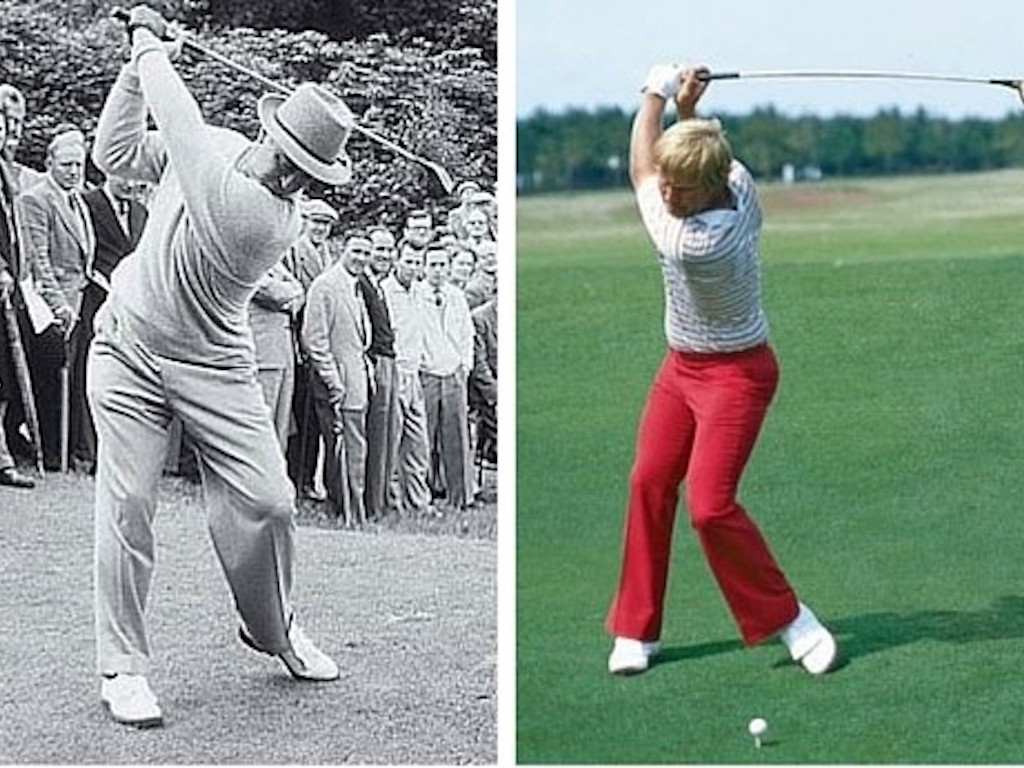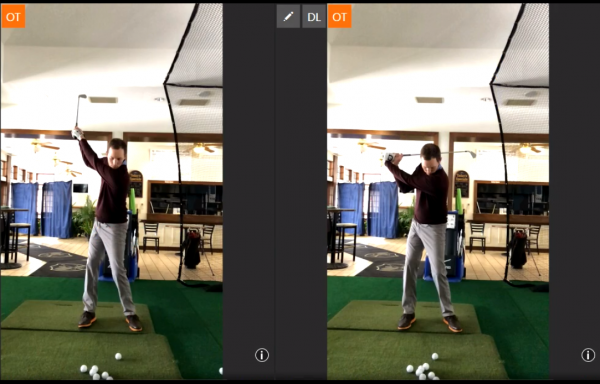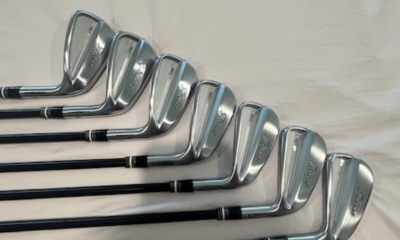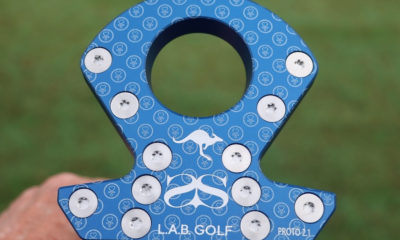Instruction
Is getting to parallel really important?

On my lesson tee, I constantly see golfers, especially senior golfers, obsessing over the mystifying position of parallel in the golf swing. Whether their swing goes past parallel or stops short of parallel it becomes a point of contention when describing their swing. Every time I put a first time student on video they make a comment about it. Why do we have a fascination with this arbitrary position? Who decided it was important? If you saw the following two swings below and had to decide which on would have the potential for more speed which swing would you choose?
Before a few weeks ago, I am not sure I would know the correct answer. After having learned some new stats from Dr. Sasho MacKenzie at a recent coaching seminar I attended I can now tell you the swing on the left would absolutely have a higher potential for more speed. According to Dr. MacKenzie’s research increasing hand path by 4 inches gives the potential for 2.4 mph of club speed. Conversely adding 30 degrees of club rotation will only add a potential of .2 mph.

Now obviously the two swings I made are a bit manufactured however I believe they illustrate a common issue I see in amateurs. I see tons of amateurs who are limited in mobility that will then allow the wrists to cock and the club to jackknife in order to reach parallel at the top. So yes you might swing the club .2 mph faster by allowing the club to get to parallel in this scenario but I would ask at what cost?
The two most common ways I see amateurs try to lengthen the club head travel for a false chase in speed is by either softening the left arm or cupping the left wrist at the top. Now plenty of all time golfers have had one or the other of these looks at the top but I think we must understand that the golf swing is a constant cause and effect relationship. I like to think about it as a system of credits and debits equaling out to a net ball flight. If we soften the left arm we shorten the radius of the arc. So, at some point in the downswing we must lengthen the radius or we will suffer in contact or potentially no contact with the ball at all!
If we cup the left wrist at the top of the swing, we are severely opening the club face. Again, this is adding another element we must “fix” on the downswing in order to hit an intended golf shot. I must remind you that all of these things are in order for a potential .2 mph of club head speed for every 30 degrees of club rotation! I just do not see the value of trying to go down this road for every day players.
If we look at some of the historically longest drivers of the golf ball you will rarely see them chasing club rotation and much more of lengthening the hand path. If you are thinking, “Well ok, but guys like Tony Finau and Jon Rahm have shorter hand paths and still bomb it.” I would concede that yes their hand path is short of parallel however that is relative to themselves. Often we are so focused on parallel we lose sight of the actual distance the hand path travels. Just because Tony Finau’s swing looks short, relative to his body, does not mean his hand path length from the ball is shorter than others. For example, Rory McIlroy is 5”9’ with a long-looking hand path but Tony is 6”4’ with a short-looking hand path. If I had to guess, I would say their hand paths are of similar length.
Now of course Tony is missing out on potential speed, because his hand path is shorter than what would seem physically possible for him. He has decided, knowingly or not, that swinging at 120 mph with a shorter hand path allows him to control the golf ball more than swinging at 130 mph with a longer hand path. It is vitally important to understand that he has speed to give up. If Webb Simpson, who swings at 109 mph, decides to shorten his hand path for more control the results of less speed and therefore distance could be disastrous.
If you cannot get to parallel in your golf swing, please do yourself and your score a favor, quit trying to increase the club’s rotation purely through wrist hinge. Also, if you have the physical ability to increase the hand path length go ahead and try it! It could do wonders for you game. Or if your kid is reaching way back at the top of the swing be very careful when deciding to shorten their swing. They are trying to create as much speed as possible to play a relatively long golf course.
Finally, it is very important to remember when applying any rules of thumb in the golf swing that it is different for every person. I have seen plenty of players who increase hand path and it actually lose swing speed because either their body cannot support it or it causes timing issues in their sequence for producing speed. If a doctor prescribes medicine for your friend, you don’t just automatically start taking the same medicine without the proper consultation. Please do yourself and your golf instructor a solid apply this same logic to your game!
- LIKE107
- LEGIT9
- WOW2
- LOL3
- IDHT1
- FLOP3
- OB3
- SHANK11
Instruction
Clement: Laid-off or perfect fade? Across-the-line or perfect draw?

Some call the image on the left laid off, but if you are hitting a fade, this could be a perfect backswing for it! Same for across the line for a draw! Stop racking your brain with perceived mistakes and simply match backswing to shot shape!
- LIKE0
- LEGIT0
- WOW0
- LOL0
- IDHT0
- FLOP0
- OB0
- SHANK1
Instruction
The Wedge Guy: The easiest-to-learn golf basic

My golf learning began with this simple fact – if you don’t have a fundamentally sound hold on the golf club, it is practically impossible for your body to execute a fundamentally sound golf swing. I’m still a big believer that the golf swing is much easier to execute if you begin with the proper hold on the club.
As you might imagine, I come into contact with hundreds of golfers of all skill levels. And it is very rare to see a good player with a bad hold on the golf club. There are some exceptions, for sure, but they are very few and very far between, and they typically have beat so many balls with their poor grip that they’ve found a way to work around it.
The reality of biophysics is that the body moves only in certain ways – and the particulars of the way you hold the golf club can totally prevent a sound swing motion that allows the club to release properly through the impact zone. The wonderful thing is that anyone can learn how to put a fundamentally sound hold on the golf club, and you can practice it anywhere your hands are not otherwise engaged, like watching TV or just sitting and relaxing.
Whether you prefer an overlap, interlock or full-finger (not baseball!) grip on the club, the same fundamentals apply. Here are the major grip faults I see most often, in the order of the frequency:
Mis-aligned hands
By this I mean that the palms of the two hands are not parallel to each other. Too many golfers have a weak left hand and strong right, or vice versa. The easiest way to learn how to hold the club with your palms aligned properly is to grip a plain wooden ruler or yardstick. It forces the hands to align properly and shows you how that feels. If you grip and re-grip a yardstick several times, then grip a club, you’ll see that the learning curve is almost immediate.
The position of the grip in the upper/left hand
I also observe many golfers who have the butt of the grip too far into the heel pad of the upper hand (the left hand for right-handed players). It’s amazing how much easier it is to release the club through the ball if even 1/4-1/2″ of the butt is beyond the left heel pad. Try this yourself to see what I mean. Swing the club freely with just your left hand and notice the difference in its release from when you hold it at the end of the grip, versus gripping down even a half inch.
To help you really understand how this works, go to the range and hit shots with your five-iron gripped down a full inch to make the club the same length as your seven-iron. You will probably see an amazing shot shape difference, and likely not see as much distance loss as you would expect.
Too much lower (right) hand on the club
It seems like almost all golfers of 8-10 handicap or higher have the club too far into the palm of the lower hand, because that feels “good” if you are trying to control the path of the clubhead to the ball. But the golf swing is not an effort to hit at the ball – it is a swing of the club. The proper hold on the club has the grip underneath the pad at the base of the fingers. This will likely feel “weak” to you — like you cannot control the club like that. EXACTLY. You should not be trying to control the club with your lower/master hand.
Gripping too tightly
Nearly all golfers hold the club too tightly, which tenses up the forearms and prevents a proper release of the club through impact. In order for the club to move back and through properly, you must feel that the club is controlled by the last three fingers of the upper hand, and the middle two fingers of the lower hand. If you engage your thumbs and forefingers in “holding” the club, the result will almost always be a grip that is too tight. Try this for yourself. Hold the club in your upper hand only, and squeeze firmly with just the last three fingers, with the forefinger and thumb off the club entirely. You have good control, but your forearms are not tense. Then begin to squeeze down with your thumb and forefinger and observe the tensing of the entire forearm. This is the way we are made, so the key to preventing tenseness in the arms is to hold the club very lightly with the “pinchers” — the thumbs and forefingers.
So, those are what I believe are the four fundamentals of a good grip. Anyone can learn them in their home or office very quickly. There is no easier way to improve your ball striking consistency and add distance than giving more attention to the way you hold the golf club.
More from the Wedge Guy
- The Wedge Guy: Golf mastery begins with your wedge game
- The Wedge Guy: Why golf is 20 times harder than brain surgery
- The Wedge Guy: Musings on the golf ball rollback
- LIKE88
- LEGIT14
- WOW6
- LOL1
- IDHT0
- FLOP4
- OB1
- SHANK8
Instruction
Clement: Stop ripping off your swing with this drill!

Not the dreaded headcover under the armpit drill! As if your body is defective and can’t function by itself! Have you seen how incredible the human machine is with all the incredible feats of agility all kinds of athletes are accomplishing? You think your body is so defective (the good Lord is laughing his head off at you) that it needs a headcover tucked under the armpit so you can swing like T-Rex?
- LIKE0
- LEGIT2
- WOW2
- LOL0
- IDHT0
- FLOP0
- OB0
- SHANK2
-

 19th Hole3 weeks ago
19th Hole3 weeks agoDave Portnoy places monstrous outright bet for the 2024 Masters
-

 19th Hole1 week ago
19th Hole1 week agoJustin Thomas on the equipment choice of Scottie Scheffler that he thinks is ‘weird’
-

 19th Hole1 week ago
19th Hole1 week ago‘Absolutely crazy’ – Major champ lays into Patrick Cantlay over his decision on final hole of RBC Heritage
-

 19th Hole2 weeks ago
19th Hole2 weeks agoTwo star names reportedly blanked Jon Rahm all week at the Masters
-

 19th Hole2 weeks ago
19th Hole2 weeks agoReport: LIV Golf identifies latest star name they hope to sign to breakaway tour
-

 19th Hole2 weeks ago
19th Hole2 weeks agoNeal Shipley presser ends in awkward fashion after reporter claims Tiger handed him note on 8th fairway
-

 19th Hole2 weeks ago
19th Hole2 weeks agoBrandel Chamblee has ‘no doubt’ who started the McIlroy/LIV rumor and why
-

 Equipment3 weeks ago
Equipment3 weeks agoWhat we know about Bryson DeChambeau’s 3D-printed Avoda irons

























Jim Gift
Feb 4, 2019 at 7:37 pm
Please explain how to correctly increase hand path and what you mean by this??
thanks, Jim
joro
Feb 4, 2019 at 12:51 pm
You don’t hit the ball with the backswing and the farther you have to get to the ball the more room for error. So for the average player shorter is better. Even most of the Tour long hitters are short of parallel. So who is to say, other than those that feel they have to change a persons swing, and have no idea how to really teach.
Ray
Feb 4, 2019 at 12:44 am
Somewhere Alan Doyle is LOL hard at this article.
James
Feb 4, 2019 at 12:10 am
Dumb question. What is hand path?
Speedy
Feb 3, 2019 at 1:03 pm
Woods parallel. Irons short of parallel. Past parallel is reckless endeavor.
geohogan
Feb 3, 2019 at 12:36 pm
Tony F has very long arms, much longer than Jack N.
His hand path is longer than Jack’s even though his shoulders appear to turn less than 90 degrees.
Yet he creates as much lag as Jack and Sam S.
Its angular momentum that creates clubhead speed and that is dependent upon lag.
Lag is dependent upon how we use our hands, not getting club to parallel at the top of BS.
Greg V
Feb 3, 2019 at 11:56 am
Good article.
In general, back when clubs were heavy – hickory and then steel – it was important to have a long swing in order to build up speed through impact. Modern drivers are much lighter, and can be accelerated faster from a shorter backswing.
Width is always important. Making a big shoulder turn and not letting the lead arm break down is much more important than swinging the club back to parallel, or beyond.